Professional Project: Employee Commitment and Organizational Culture
VerifiedAdded on 2020/03/02
|10
|2307
|244
Report
AI Summary
This professional project examines the impact of employee commitment on organizational culture, focusing on the context of Qatar. The research investigates how employee commitment, defined as the degree to which employees feel dedicated to their organization, influences operational productivity and shapes organizational culture. The study explores the relationship between employee commitment and organizational culture, considering the influence of national culture. The report reviews existing literature, including various definitions of commitment and the factors affecting it, such as job enrichment and leadership styles. The research methodology employs positivism and a deductive approach, utilizing secondary data analysis, including qualitative data collected through surveys and interviews. The project outlines a detailed timeline for completion, covering topic selection, literature review, methodology, data collection, analysis, and conclusion. The report aims to provide insights into the dynamics of commitment and its influence on organizational culture.
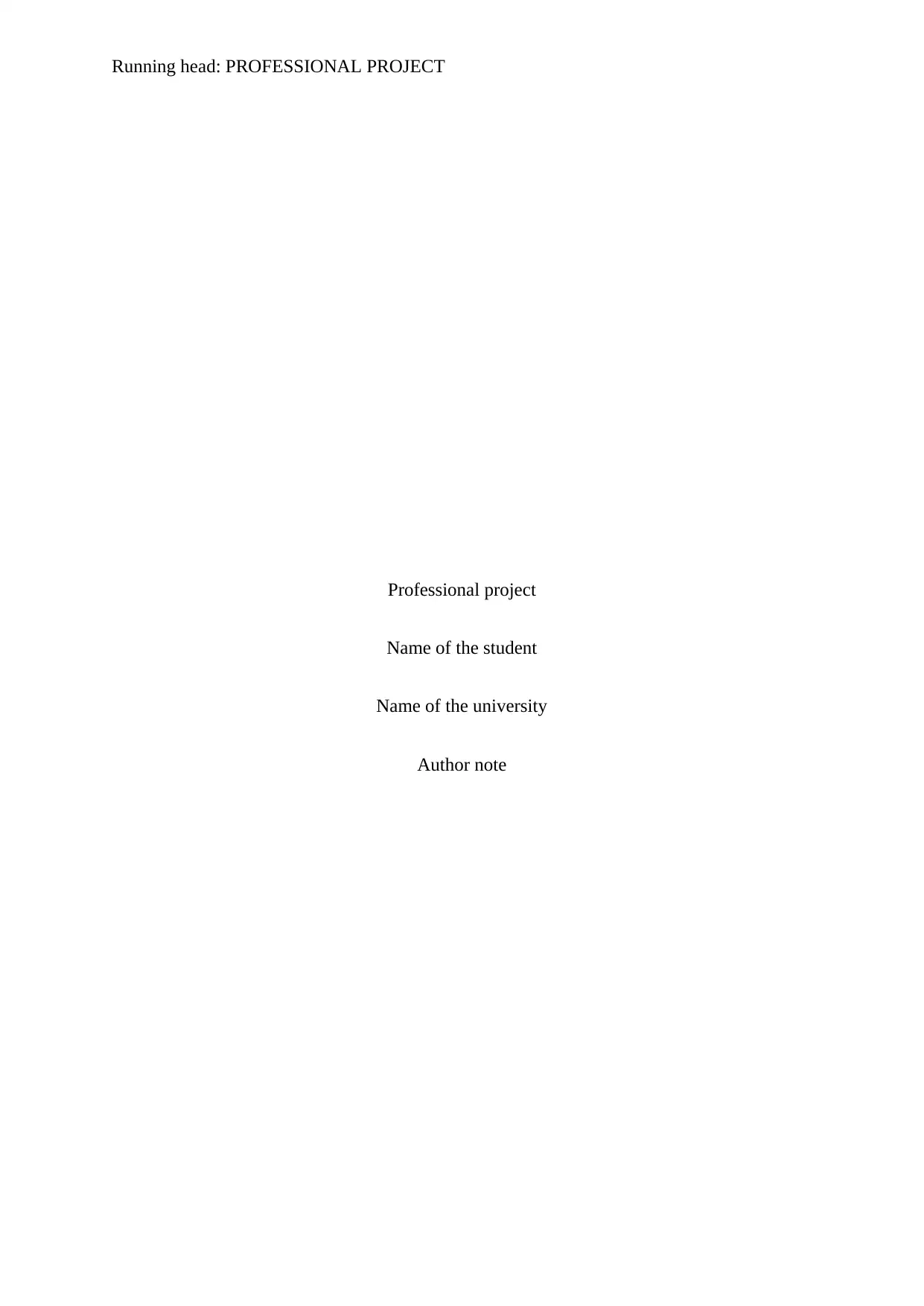
Running head: PROFESSIONAL PROJECT
Professional project
Name of the student
Name of the university
Author note
Professional project
Name of the student
Name of the university
Author note
Paraphrase This Document
Need a fresh take? Get an instant paraphrase of this document with our AI Paraphraser
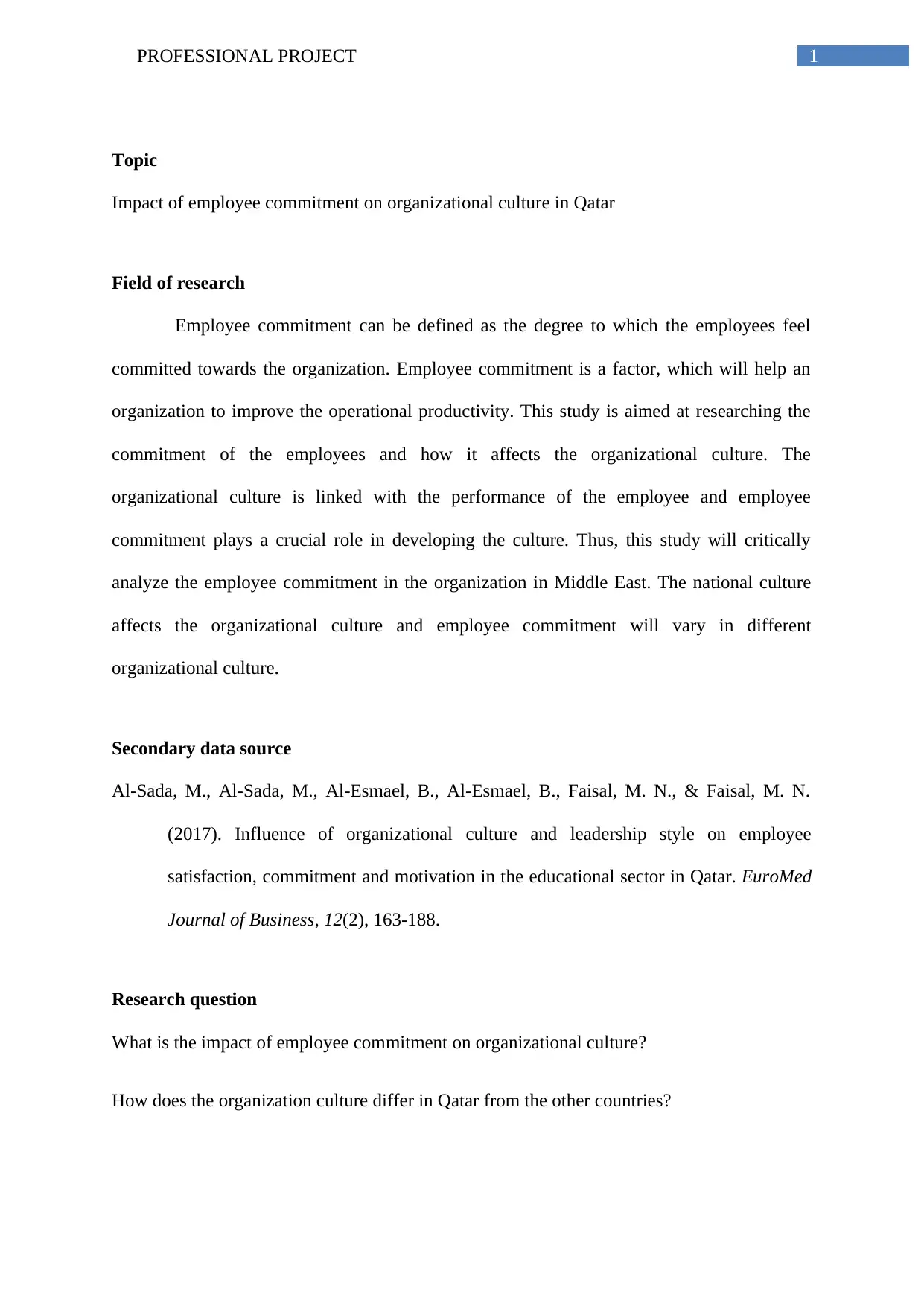
1PROFESSIONAL PROJECT
Topic
Impact of employee commitment on organizational culture in Qatar
Field of research
Employee commitment can be defined as the degree to which the employees feel
committed towards the organization. Employee commitment is a factor, which will help an
organization to improve the operational productivity. This study is aimed at researching the
commitment of the employees and how it affects the organizational culture. The
organizational culture is linked with the performance of the employee and employee
commitment plays a crucial role in developing the culture. Thus, this study will critically
analyze the employee commitment in the organization in Middle East. The national culture
affects the organizational culture and employee commitment will vary in different
organizational culture.
Secondary data source
Al-Sada, M., Al-Sada, M., Al-Esmael, B., Al-Esmael, B., Faisal, M. N., & Faisal, M. N.
(2017). Influence of organizational culture and leadership style on employee
satisfaction, commitment and motivation in the educational sector in Qatar. EuroMed
Journal of Business, 12(2), 163-188.
Research question
What is the impact of employee commitment on organizational culture?
How does the organization culture differ in Qatar from the other countries?
Topic
Impact of employee commitment on organizational culture in Qatar
Field of research
Employee commitment can be defined as the degree to which the employees feel
committed towards the organization. Employee commitment is a factor, which will help an
organization to improve the operational productivity. This study is aimed at researching the
commitment of the employees and how it affects the organizational culture. The
organizational culture is linked with the performance of the employee and employee
commitment plays a crucial role in developing the culture. Thus, this study will critically
analyze the employee commitment in the organization in Middle East. The national culture
affects the organizational culture and employee commitment will vary in different
organizational culture.
Secondary data source
Al-Sada, M., Al-Sada, M., Al-Esmael, B., Al-Esmael, B., Faisal, M. N., & Faisal, M. N.
(2017). Influence of organizational culture and leadership style on employee
satisfaction, commitment and motivation in the educational sector in Qatar. EuroMed
Journal of Business, 12(2), 163-188.
Research question
What is the impact of employee commitment on organizational culture?
How does the organization culture differ in Qatar from the other countries?
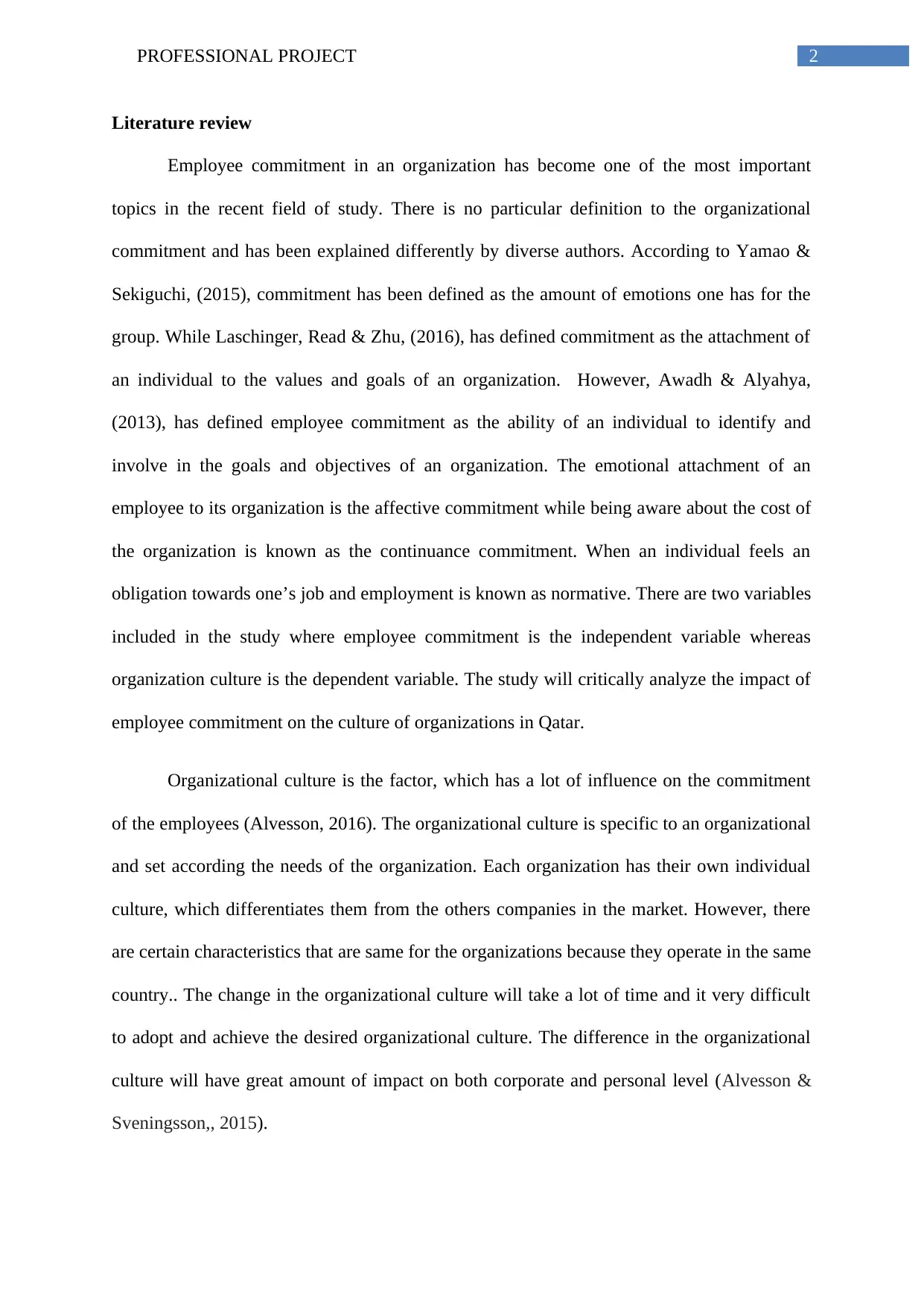
2PROFESSIONAL PROJECT
Literature review
Employee commitment in an organization has become one of the most important
topics in the recent field of study. There is no particular definition to the organizational
commitment and has been explained differently by diverse authors. According to Yamao &
Sekiguchi, (2015), commitment has been defined as the amount of emotions one has for the
group. While Laschinger, Read & Zhu, (2016), has defined commitment as the attachment of
an individual to the values and goals of an organization. However, Awadh & Alyahya,
(2013), has defined employee commitment as the ability of an individual to identify and
involve in the goals and objectives of an organization. The emotional attachment of an
employee to its organization is the affective commitment while being aware about the cost of
the organization is known as the continuance commitment. When an individual feels an
obligation towards one’s job and employment is known as normative. There are two variables
included in the study where employee commitment is the independent variable whereas
organization culture is the dependent variable. The study will critically analyze the impact of
employee commitment on the culture of organizations in Qatar.
Organizational culture is the factor, which has a lot of influence on the commitment
of the employees (Alvesson, 2016). The organizational culture is specific to an organizational
and set according the needs of the organization. Each organization has their own individual
culture, which differentiates them from the others companies in the market. However, there
are certain characteristics that are same for the organizations because they operate in the same
country.. The change in the organizational culture will take a lot of time and it very difficult
to adopt and achieve the desired organizational culture. The difference in the organizational
culture will have great amount of impact on both corporate and personal level (Alvesson &
Sveningsson,, 2015).
Literature review
Employee commitment in an organization has become one of the most important
topics in the recent field of study. There is no particular definition to the organizational
commitment and has been explained differently by diverse authors. According to Yamao &
Sekiguchi, (2015), commitment has been defined as the amount of emotions one has for the
group. While Laschinger, Read & Zhu, (2016), has defined commitment as the attachment of
an individual to the values and goals of an organization. However, Awadh & Alyahya,
(2013), has defined employee commitment as the ability of an individual to identify and
involve in the goals and objectives of an organization. The emotional attachment of an
employee to its organization is the affective commitment while being aware about the cost of
the organization is known as the continuance commitment. When an individual feels an
obligation towards one’s job and employment is known as normative. There are two variables
included in the study where employee commitment is the independent variable whereas
organization culture is the dependent variable. The study will critically analyze the impact of
employee commitment on the culture of organizations in Qatar.
Organizational culture is the factor, which has a lot of influence on the commitment
of the employees (Alvesson, 2016). The organizational culture is specific to an organizational
and set according the needs of the organization. Each organization has their own individual
culture, which differentiates them from the others companies in the market. However, there
are certain characteristics that are same for the organizations because they operate in the same
country.. The change in the organizational culture will take a lot of time and it very difficult
to adopt and achieve the desired organizational culture. The difference in the organizational
culture will have great amount of impact on both corporate and personal level (Alvesson &
Sveningsson,, 2015).
⊘ This is a preview!⊘
Do you want full access?
Subscribe today to unlock all pages.

Trusted by 1+ million students worldwide
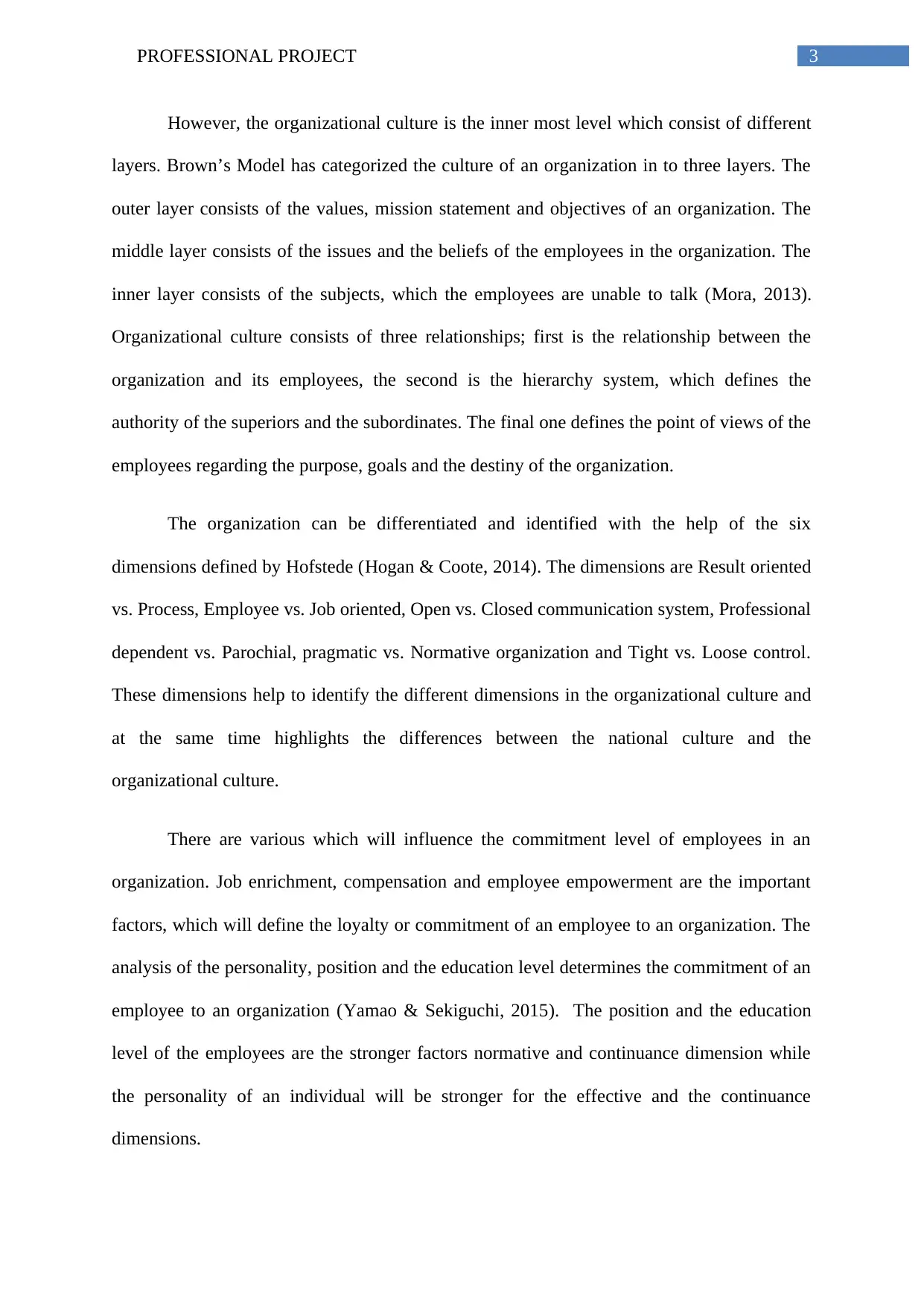
3PROFESSIONAL PROJECT
However, the organizational culture is the inner most level which consist of different
layers. Brown’s Model has categorized the culture of an organization in to three layers. The
outer layer consists of the values, mission statement and objectives of an organization. The
middle layer consists of the issues and the beliefs of the employees in the organization. The
inner layer consists of the subjects, which the employees are unable to talk (Mora, 2013).
Organizational culture consists of three relationships; first is the relationship between the
organization and its employees, the second is the hierarchy system, which defines the
authority of the superiors and the subordinates. The final one defines the point of views of the
employees regarding the purpose, goals and the destiny of the organization.
The organization can be differentiated and identified with the help of the six
dimensions defined by Hofstede (Hogan & Coote, 2014). The dimensions are Result oriented
vs. Process, Employee vs. Job oriented, Open vs. Closed communication system, Professional
dependent vs. Parochial, pragmatic vs. Normative organization and Tight vs. Loose control.
These dimensions help to identify the different dimensions in the organizational culture and
at the same time highlights the differences between the national culture and the
organizational culture.
There are various which will influence the commitment level of employees in an
organization. Job enrichment, compensation and employee empowerment are the important
factors, which will define the loyalty or commitment of an employee to an organization. The
analysis of the personality, position and the education level determines the commitment of an
employee to an organization (Yamao & Sekiguchi, 2015). The position and the education
level of the employees are the stronger factors normative and continuance dimension while
the personality of an individual will be stronger for the effective and the continuance
dimensions.
However, the organizational culture is the inner most level which consist of different
layers. Brown’s Model has categorized the culture of an organization in to three layers. The
outer layer consists of the values, mission statement and objectives of an organization. The
middle layer consists of the issues and the beliefs of the employees in the organization. The
inner layer consists of the subjects, which the employees are unable to talk (Mora, 2013).
Organizational culture consists of three relationships; first is the relationship between the
organization and its employees, the second is the hierarchy system, which defines the
authority of the superiors and the subordinates. The final one defines the point of views of the
employees regarding the purpose, goals and the destiny of the organization.
The organization can be differentiated and identified with the help of the six
dimensions defined by Hofstede (Hogan & Coote, 2014). The dimensions are Result oriented
vs. Process, Employee vs. Job oriented, Open vs. Closed communication system, Professional
dependent vs. Parochial, pragmatic vs. Normative organization and Tight vs. Loose control.
These dimensions help to identify the different dimensions in the organizational culture and
at the same time highlights the differences between the national culture and the
organizational culture.
There are various which will influence the commitment level of employees in an
organization. Job enrichment, compensation and employee empowerment are the important
factors, which will define the loyalty or commitment of an employee to an organization. The
analysis of the personality, position and the education level determines the commitment of an
employee to an organization (Yamao & Sekiguchi, 2015). The position and the education
level of the employees are the stronger factors normative and continuance dimension while
the personality of an individual will be stronger for the effective and the continuance
dimensions.
Paraphrase This Document
Need a fresh take? Get an instant paraphrase of this document with our AI Paraphraser
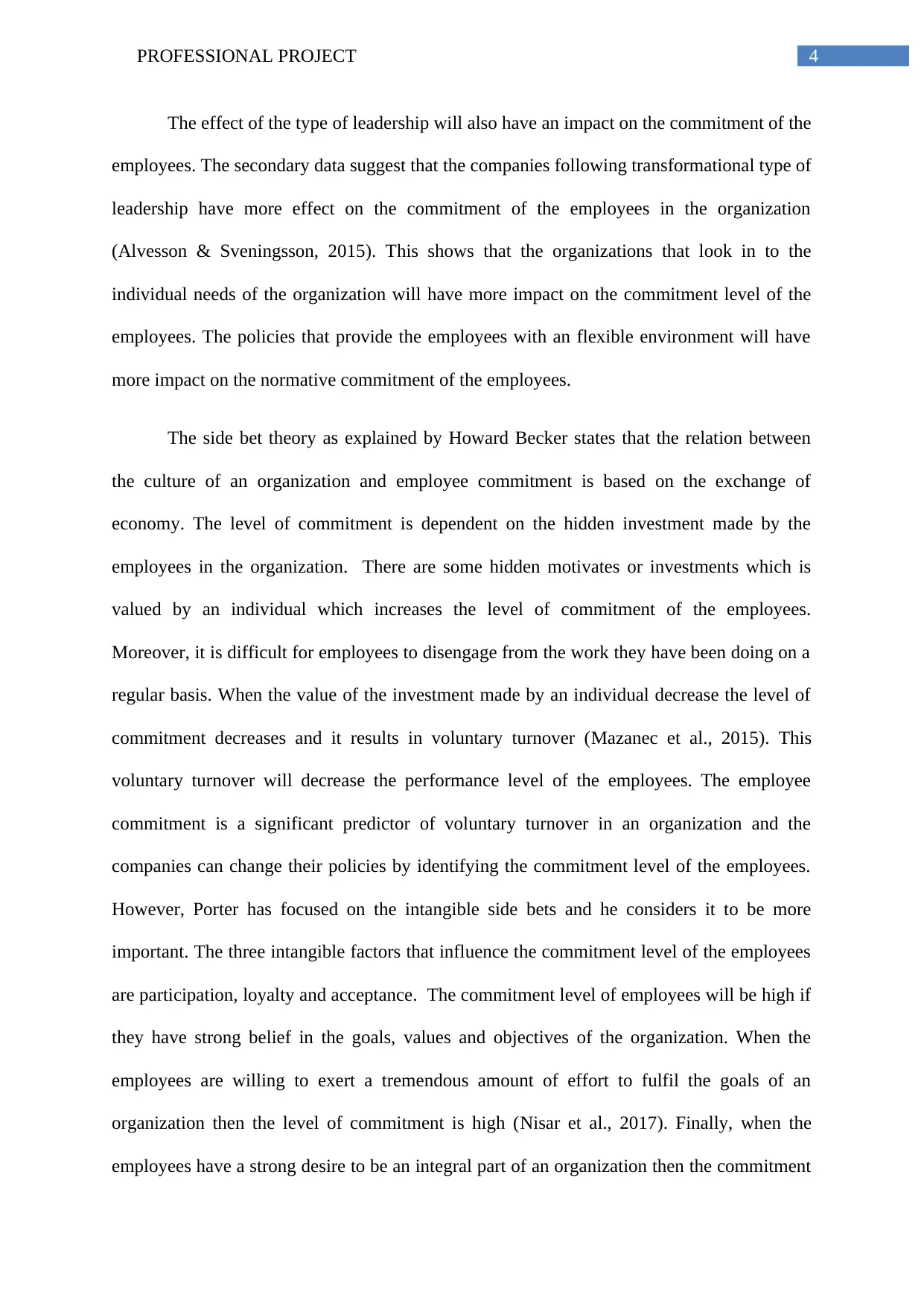
4PROFESSIONAL PROJECT
The effect of the type of leadership will also have an impact on the commitment of the
employees. The secondary data suggest that the companies following transformational type of
leadership have more effect on the commitment of the employees in the organization
(Alvesson & Sveningsson, 2015). This shows that the organizations that look in to the
individual needs of the organization will have more impact on the commitment level of the
employees. The policies that provide the employees with an flexible environment will have
more impact on the normative commitment of the employees.
The side bet theory as explained by Howard Becker states that the relation between
the culture of an organization and employee commitment is based on the exchange of
economy. The level of commitment is dependent on the hidden investment made by the
employees in the organization. There are some hidden motivates or investments which is
valued by an individual which increases the level of commitment of the employees.
Moreover, it is difficult for employees to disengage from the work they have been doing on a
regular basis. When the value of the investment made by an individual decrease the level of
commitment decreases and it results in voluntary turnover (Mazanec et al., 2015). This
voluntary turnover will decrease the performance level of the employees. The employee
commitment is a significant predictor of voluntary turnover in an organization and the
companies can change their policies by identifying the commitment level of the employees.
However, Porter has focused on the intangible side bets and he considers it to be more
important. The three intangible factors that influence the commitment level of the employees
are participation, loyalty and acceptance. The commitment level of employees will be high if
they have strong belief in the goals, values and objectives of the organization. When the
employees are willing to exert a tremendous amount of effort to fulfil the goals of an
organization then the level of commitment is high (Nisar et al., 2017). Finally, when the
employees have a strong desire to be an integral part of an organization then the commitment
The effect of the type of leadership will also have an impact on the commitment of the
employees. The secondary data suggest that the companies following transformational type of
leadership have more effect on the commitment of the employees in the organization
(Alvesson & Sveningsson, 2015). This shows that the organizations that look in to the
individual needs of the organization will have more impact on the commitment level of the
employees. The policies that provide the employees with an flexible environment will have
more impact on the normative commitment of the employees.
The side bet theory as explained by Howard Becker states that the relation between
the culture of an organization and employee commitment is based on the exchange of
economy. The level of commitment is dependent on the hidden investment made by the
employees in the organization. There are some hidden motivates or investments which is
valued by an individual which increases the level of commitment of the employees.
Moreover, it is difficult for employees to disengage from the work they have been doing on a
regular basis. When the value of the investment made by an individual decrease the level of
commitment decreases and it results in voluntary turnover (Mazanec et al., 2015). This
voluntary turnover will decrease the performance level of the employees. The employee
commitment is a significant predictor of voluntary turnover in an organization and the
companies can change their policies by identifying the commitment level of the employees.
However, Porter has focused on the intangible side bets and he considers it to be more
important. The three intangible factors that influence the commitment level of the employees
are participation, loyalty and acceptance. The commitment level of employees will be high if
they have strong belief in the goals, values and objectives of the organization. When the
employees are willing to exert a tremendous amount of effort to fulfil the goals of an
organization then the level of commitment is high (Nisar et al., 2017). Finally, when the
employees have a strong desire to be an integral part of an organization then the commitment
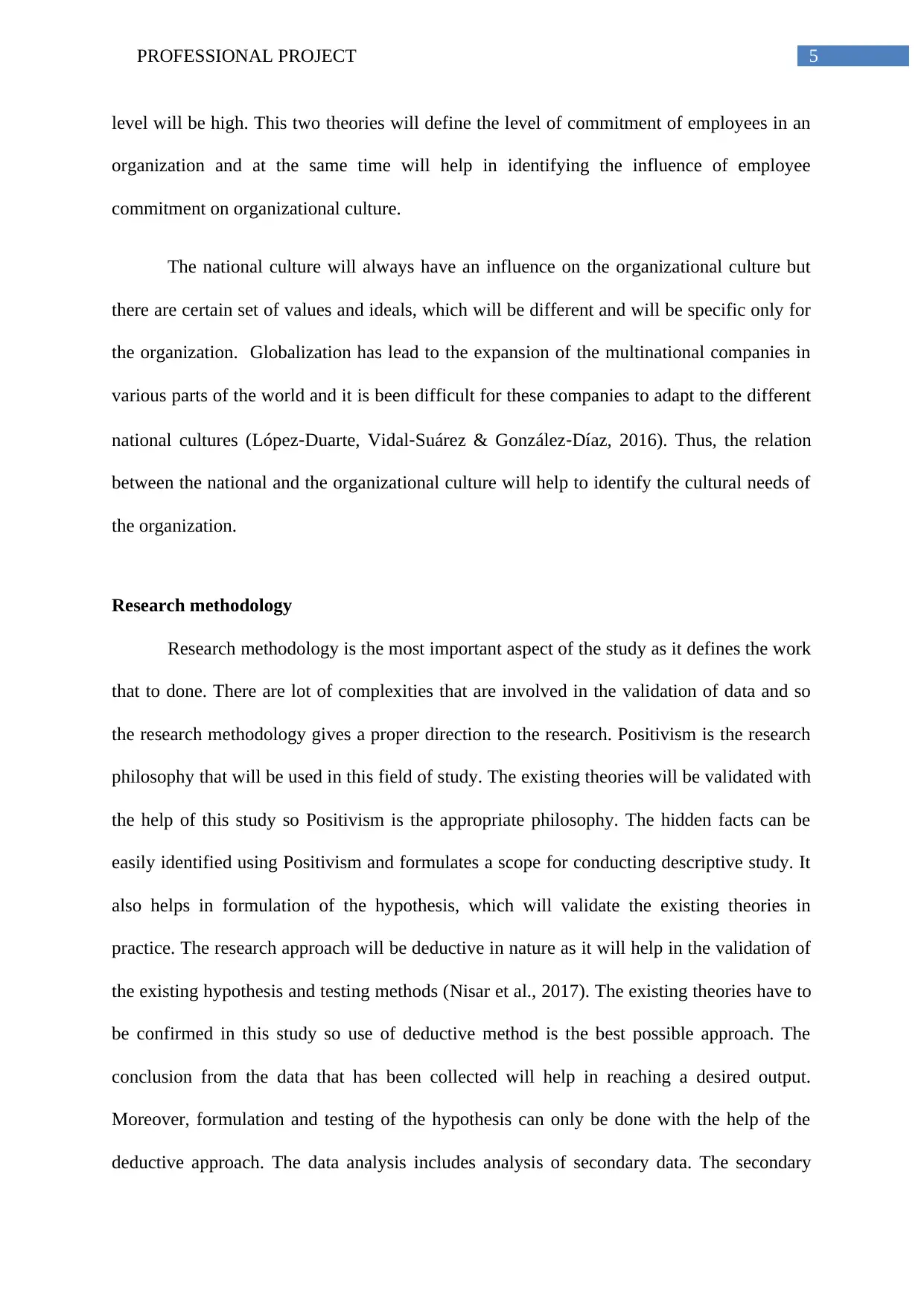
5PROFESSIONAL PROJECT
level will be high. This two theories will define the level of commitment of employees in an
organization and at the same time will help in identifying the influence of employee
commitment on organizational culture.
The national culture will always have an influence on the organizational culture but
there are certain set of values and ideals, which will be different and will be specific only for
the organization. Globalization has lead to the expansion of the multinational companies in
various parts of the world and it is been difficult for these companies to adapt to the different
national cultures (López‐Duarte, Vidal‐Suárez & González‐Díaz, 2016). Thus, the relation
between the national and the organizational culture will help to identify the cultural needs of
the organization.
Research methodology
Research methodology is the most important aspect of the study as it defines the work
that to done. There are lot of complexities that are involved in the validation of data and so
the research methodology gives a proper direction to the research. Positivism is the research
philosophy that will be used in this field of study. The existing theories will be validated with
the help of this study so Positivism is the appropriate philosophy. The hidden facts can be
easily identified using Positivism and formulates a scope for conducting descriptive study. It
also helps in formulation of the hypothesis, which will validate the existing theories in
practice. The research approach will be deductive in nature as it will help in the validation of
the existing hypothesis and testing methods (Nisar et al., 2017). The existing theories have to
be confirmed in this study so use of deductive method is the best possible approach. The
conclusion from the data that has been collected will help in reaching a desired output.
Moreover, formulation and testing of the hypothesis can only be done with the help of the
deductive approach. The data analysis includes analysis of secondary data. The secondary
level will be high. This two theories will define the level of commitment of employees in an
organization and at the same time will help in identifying the influence of employee
commitment on organizational culture.
The national culture will always have an influence on the organizational culture but
there are certain set of values and ideals, which will be different and will be specific only for
the organization. Globalization has lead to the expansion of the multinational companies in
various parts of the world and it is been difficult for these companies to adapt to the different
national cultures (López‐Duarte, Vidal‐Suárez & González‐Díaz, 2016). Thus, the relation
between the national and the organizational culture will help to identify the cultural needs of
the organization.
Research methodology
Research methodology is the most important aspect of the study as it defines the work
that to done. There are lot of complexities that are involved in the validation of data and so
the research methodology gives a proper direction to the research. Positivism is the research
philosophy that will be used in this field of study. The existing theories will be validated with
the help of this study so Positivism is the appropriate philosophy. The hidden facts can be
easily identified using Positivism and formulates a scope for conducting descriptive study. It
also helps in formulation of the hypothesis, which will validate the existing theories in
practice. The research approach will be deductive in nature as it will help in the validation of
the existing hypothesis and testing methods (Nisar et al., 2017). The existing theories have to
be confirmed in this study so use of deductive method is the best possible approach. The
conclusion from the data that has been collected will help in reaching a desired output.
Moreover, formulation and testing of the hypothesis can only be done with the help of the
deductive approach. The data analysis includes analysis of secondary data. The secondary
⊘ This is a preview!⊘
Do you want full access?
Subscribe today to unlock all pages.

Trusted by 1+ million students worldwide
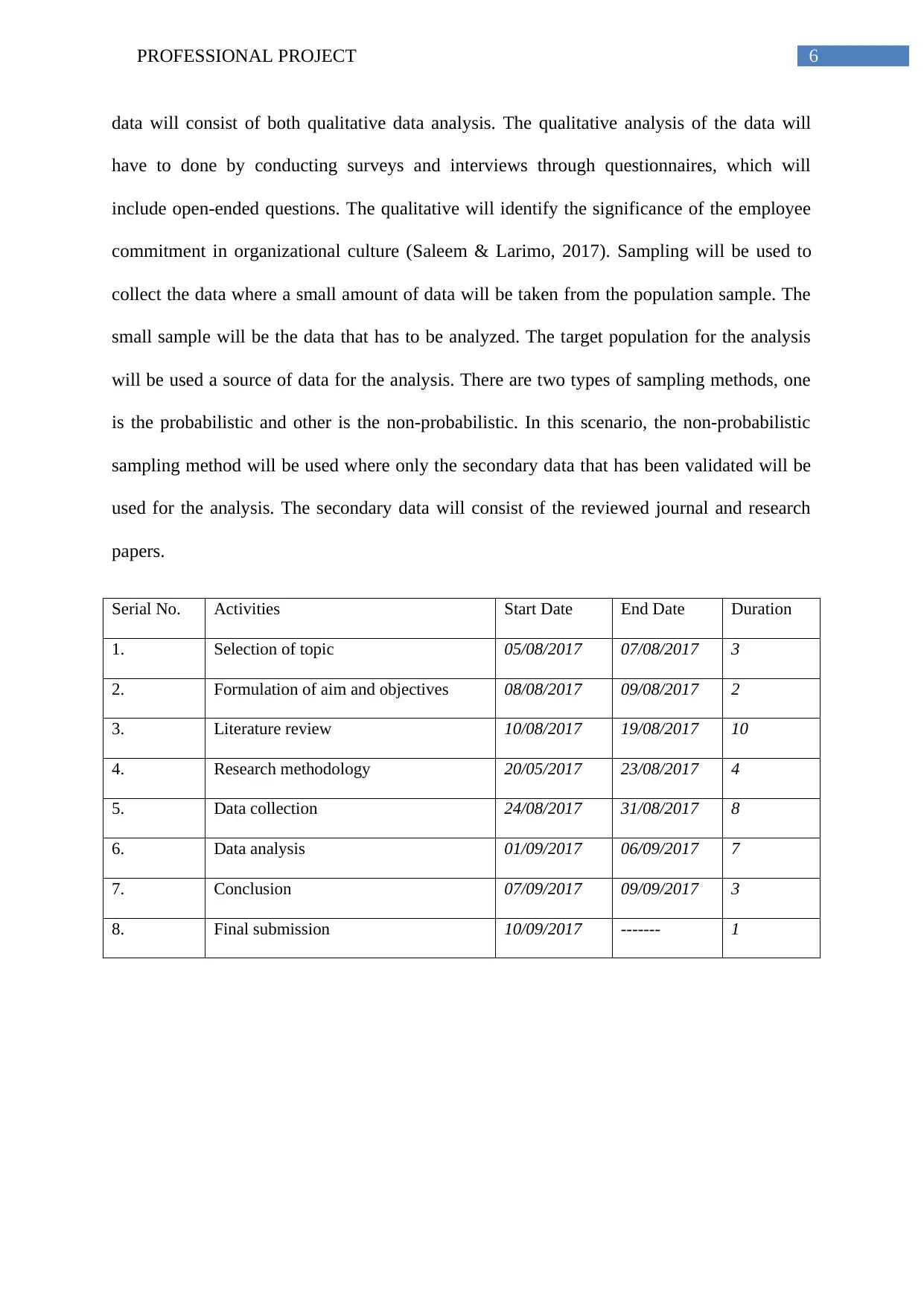
6PROFESSIONAL PROJECT
data will consist of both qualitative data analysis. The qualitative analysis of the data will
have to done by conducting surveys and interviews through questionnaires, which will
include open-ended questions. The qualitative will identify the significance of the employee
commitment in organizational culture (Saleem & Larimo, 2017). Sampling will be used to
collect the data where a small amount of data will be taken from the population sample. The
small sample will be the data that has to be analyzed. The target population for the analysis
will be used a source of data for the analysis. There are two types of sampling methods, one
is the probabilistic and other is the non-probabilistic. In this scenario, the non-probabilistic
sampling method will be used where only the secondary data that has been validated will be
used for the analysis. The secondary data will consist of the reviewed journal and research
papers.
Serial No. Activities Start Date End Date Duration
1. Selection of topic 05/08/2017 07/08/2017 3
2. Formulation of aim and objectives 08/08/2017 09/08/2017 2
3. Literature review 10/08/2017 19/08/2017 10
4. Research methodology 20/05/2017 23/08/2017 4
5. Data collection 24/08/2017 31/08/2017 8
6. Data analysis 01/09/2017 06/09/2017 7
7. Conclusion 07/09/2017 09/09/2017 3
8. Final submission 10/09/2017 ------- 1
data will consist of both qualitative data analysis. The qualitative analysis of the data will
have to done by conducting surveys and interviews through questionnaires, which will
include open-ended questions. The qualitative will identify the significance of the employee
commitment in organizational culture (Saleem & Larimo, 2017). Sampling will be used to
collect the data where a small amount of data will be taken from the population sample. The
small sample will be the data that has to be analyzed. The target population for the analysis
will be used a source of data for the analysis. There are two types of sampling methods, one
is the probabilistic and other is the non-probabilistic. In this scenario, the non-probabilistic
sampling method will be used where only the secondary data that has been validated will be
used for the analysis. The secondary data will consist of the reviewed journal and research
papers.
Serial No. Activities Start Date End Date Duration
1. Selection of topic 05/08/2017 07/08/2017 3
2. Formulation of aim and objectives 08/08/2017 09/08/2017 2
3. Literature review 10/08/2017 19/08/2017 10
4. Research methodology 20/05/2017 23/08/2017 4
5. Data collection 24/08/2017 31/08/2017 8
6. Data analysis 01/09/2017 06/09/2017 7
7. Conclusion 07/09/2017 09/09/2017 3
8. Final submission 10/09/2017 ------- 1
Paraphrase This Document
Need a fresh take? Get an instant paraphrase of this document with our AI Paraphraser
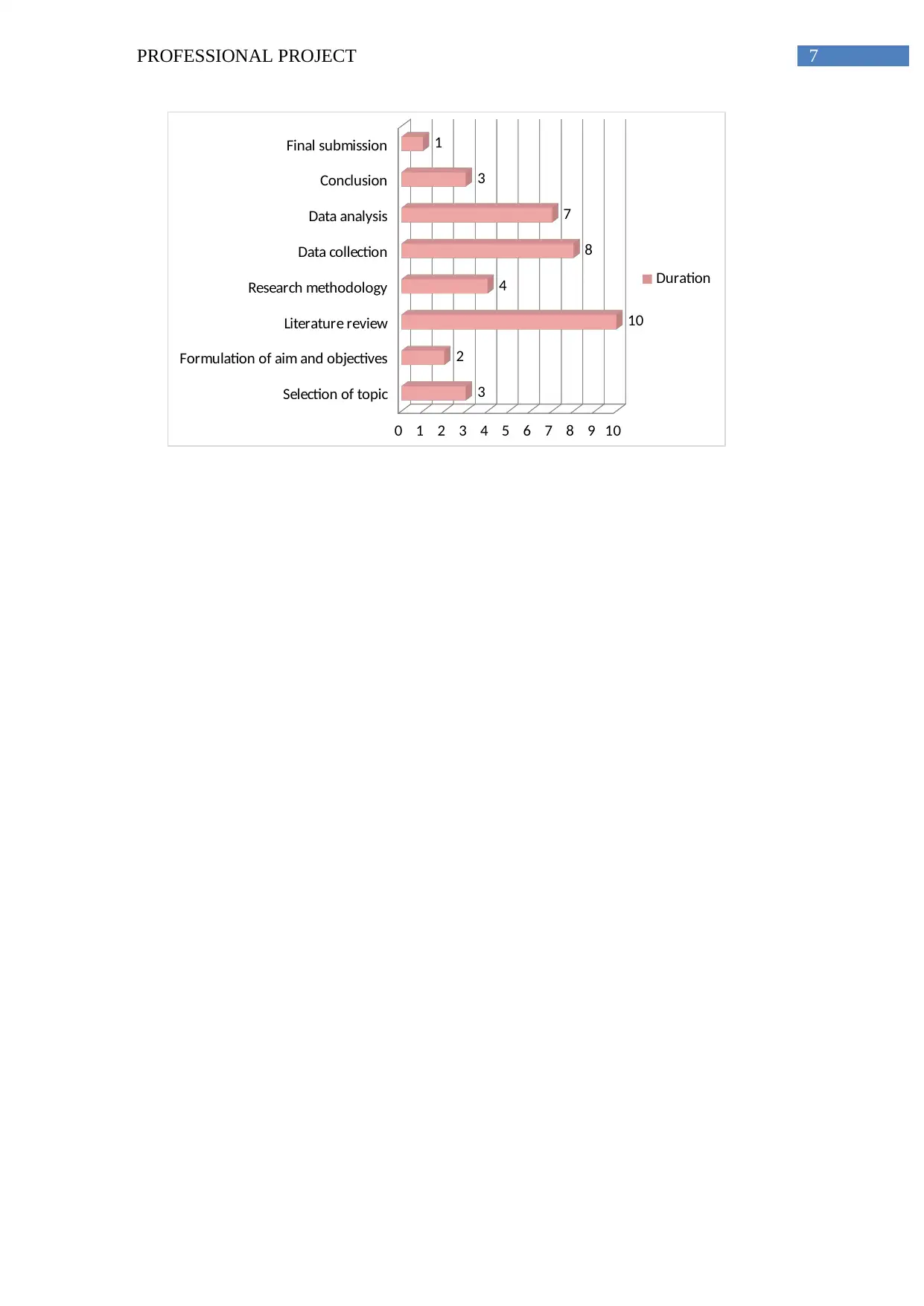
7PROFESSIONAL PROJECT
Selection of topic
Formulation of aim and objectives
Literature review
Research methodology
Data collection
Data analysis
Conclusion
Final submission
0 1 2 3 4 5 6 7 8 9 10
3
2
10
4
8
7
3
1
Duration
Selection of topic
Formulation of aim and objectives
Literature review
Research methodology
Data collection
Data analysis
Conclusion
Final submission
0 1 2 3 4 5 6 7 8 9 10
3
2
10
4
8
7
3
1
Duration
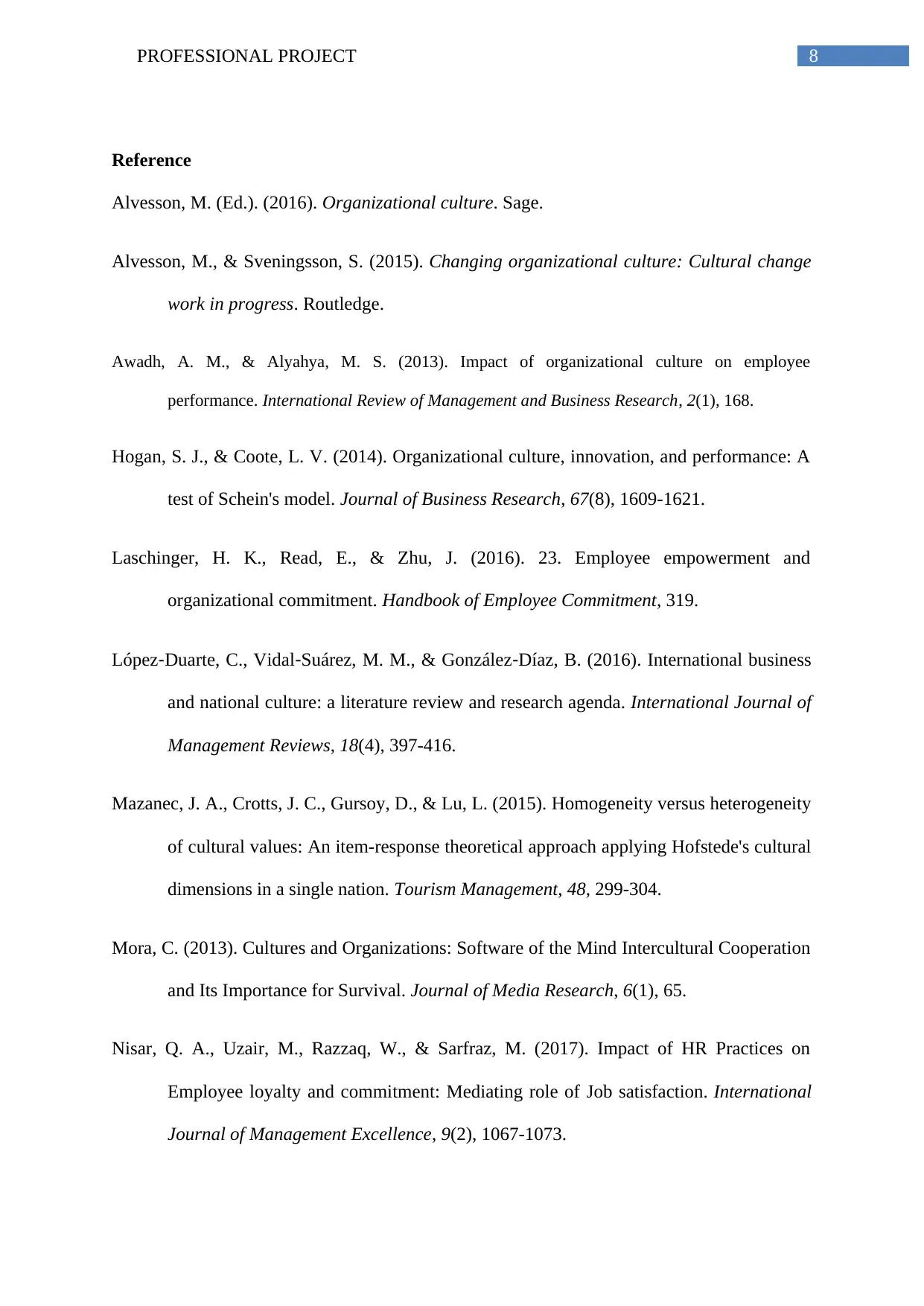
8PROFESSIONAL PROJECT
Reference
Alvesson, M. (Ed.). (2016). Organizational culture. Sage.
Alvesson, M., & Sveningsson, S. (2015). Changing organizational culture: Cultural change
work in progress. Routledge.
Awadh, A. M., & Alyahya, M. S. (2013). Impact of organizational culture on employee
performance. International Review of Management and Business Research, 2(1), 168.
Hogan, S. J., & Coote, L. V. (2014). Organizational culture, innovation, and performance: A
test of Schein's model. Journal of Business Research, 67(8), 1609-1621.
Laschinger, H. K., Read, E., & Zhu, J. (2016). 23. Employee empowerment and
organizational commitment. Handbook of Employee Commitment, 319.
López‐Duarte, C., Vidal‐Suárez, M. M., & González‐Díaz, B. (2016). International business
and national culture: a literature review and research agenda. International Journal of
Management Reviews, 18(4), 397-416.
Mazanec, J. A., Crotts, J. C., Gursoy, D., & Lu, L. (2015). Homogeneity versus heterogeneity
of cultural values: An item-response theoretical approach applying Hofstede's cultural
dimensions in a single nation. Tourism Management, 48, 299-304.
Mora, C. (2013). Cultures and Organizations: Software of the Mind Intercultural Cooperation
and Its Importance for Survival. Journal of Media Research, 6(1), 65.
Nisar, Q. A., Uzair, M., Razzaq, W., & Sarfraz, M. (2017). Impact of HR Practices on
Employee loyalty and commitment: Mediating role of Job satisfaction. International
Journal of Management Excellence, 9(2), 1067-1073.
Reference
Alvesson, M. (Ed.). (2016). Organizational culture. Sage.
Alvesson, M., & Sveningsson, S. (2015). Changing organizational culture: Cultural change
work in progress. Routledge.
Awadh, A. M., & Alyahya, M. S. (2013). Impact of organizational culture on employee
performance. International Review of Management and Business Research, 2(1), 168.
Hogan, S. J., & Coote, L. V. (2014). Organizational culture, innovation, and performance: A
test of Schein's model. Journal of Business Research, 67(8), 1609-1621.
Laschinger, H. K., Read, E., & Zhu, J. (2016). 23. Employee empowerment and
organizational commitment. Handbook of Employee Commitment, 319.
López‐Duarte, C., Vidal‐Suárez, M. M., & González‐Díaz, B. (2016). International business
and national culture: a literature review and research agenda. International Journal of
Management Reviews, 18(4), 397-416.
Mazanec, J. A., Crotts, J. C., Gursoy, D., & Lu, L. (2015). Homogeneity versus heterogeneity
of cultural values: An item-response theoretical approach applying Hofstede's cultural
dimensions in a single nation. Tourism Management, 48, 299-304.
Mora, C. (2013). Cultures and Organizations: Software of the Mind Intercultural Cooperation
and Its Importance for Survival. Journal of Media Research, 6(1), 65.
Nisar, Q. A., Uzair, M., Razzaq, W., & Sarfraz, M. (2017). Impact of HR Practices on
Employee loyalty and commitment: Mediating role of Job satisfaction. International
Journal of Management Excellence, 9(2), 1067-1073.
⊘ This is a preview!⊘
Do you want full access?
Subscribe today to unlock all pages.

Trusted by 1+ million students worldwide
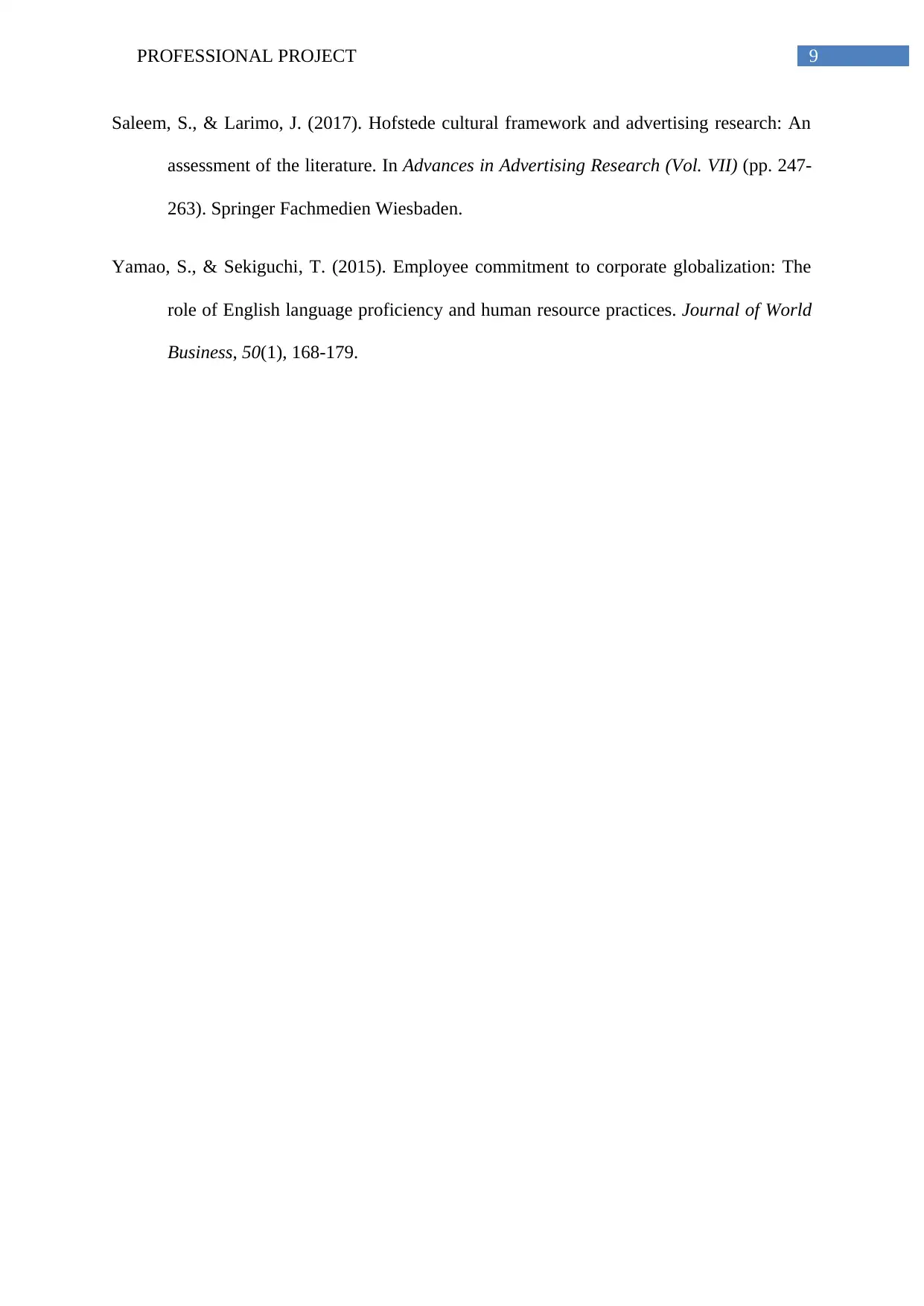
9PROFESSIONAL PROJECT
Saleem, S., & Larimo, J. (2017). Hofstede cultural framework and advertising research: An
assessment of the literature. In Advances in Advertising Research (Vol. VII) (pp. 247-
263). Springer Fachmedien Wiesbaden.
Yamao, S., & Sekiguchi, T. (2015). Employee commitment to corporate globalization: The
role of English language proficiency and human resource practices. Journal of World
Business, 50(1), 168-179.
Saleem, S., & Larimo, J. (2017). Hofstede cultural framework and advertising research: An
assessment of the literature. In Advances in Advertising Research (Vol. VII) (pp. 247-
263). Springer Fachmedien Wiesbaden.
Yamao, S., & Sekiguchi, T. (2015). Employee commitment to corporate globalization: The
role of English language proficiency and human resource practices. Journal of World
Business, 50(1), 168-179.
1 out of 10
Related Documents
Your All-in-One AI-Powered Toolkit for Academic Success.
+13062052269
info@desklib.com
Available 24*7 on WhatsApp / Email
![[object Object]](/_next/static/media/star-bottom.7253800d.svg)
Unlock your academic potential
Copyright © 2020–2025 A2Z Services. All Rights Reserved. Developed and managed by ZUCOL.




